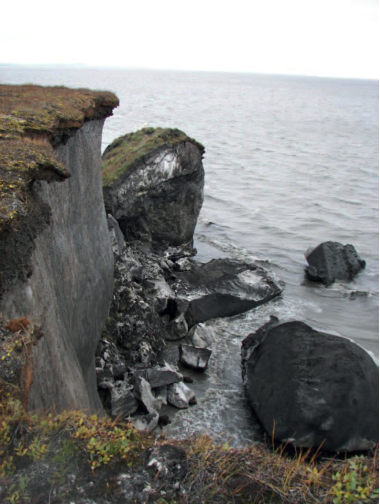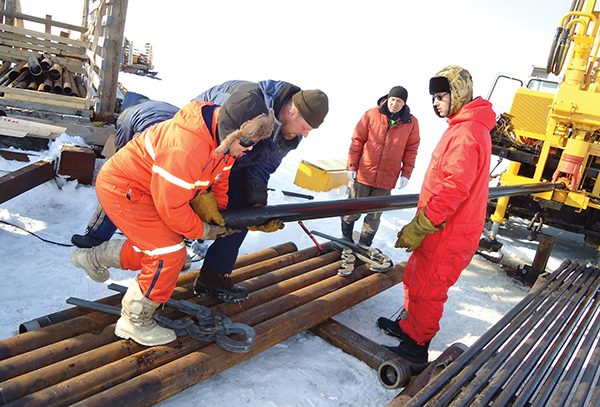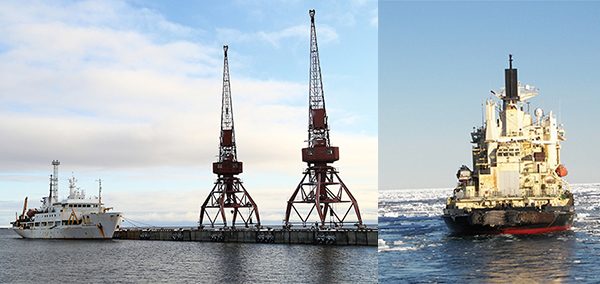Thawing permafrost, freshwater drive Arctic Ocean acidification
April 18, 2016
Yuri Bult-Ito
907-474-2462
The ocean region's acidity now exceeds the threshold at which some tiny marine organisms can build protective shells, researchers said.
Ocean acidification is considered to be a direct effect of atmospheric carbon dioxide entering the water. Accumulation of atmospheric carbon dioxide in surface waters is predicted to make the ocean twice as acidic by the end of this century as human activities such as burning fossil fuels release more carbon dioxide. The Arctic Ocean is especially sensitive to ocean acidification because more carbon dioxide can dissolve in cold water.

The current study shows, however, that carbon dioxide uptake from the atmosphere is not the major cause of the acidification in the East Siberian Arctic Shelf.
The researchers studied the chemical and physical characteristics of ESAS waters over 13 years since 1999. Using carbon isotopic data and simulations of water sources, they found that degradation of terrestrial organic matter from thawing coastal permafrost and discharge of Arctic river water with elevated carbon dioxide concentrations drive the persistent acidification.
“We studied the level of aragonite, a carbonate mineral that is necessary for some marine organisms to survive,” explained Igor Semiletov, lead author of the paper and a scientist with the International Arctic Research Center at the University of Alaska Fairbanks.
“We found extreme aragonite undersaturation in the ESAS, which means the aragonite concentration has dropped way below its threshold,” he said.
“This indicates that acidity levels of this region are much higher than those projected for 2100, which were based only on atmospheric CO2 uptake,” added Natalia Shakhova, another author of the paper and a scientist with IARC.

Four large Arctic rivers gather water from extensive permafrost-underlain watersheds and discharge in the ESAS.
The study warns that ESAS waters may become more acidic if thawing permafrost increases terrestrial organic carbon inputs and if freshwater discharge continues to increase.
“ESAS covers more than one-fourth of the Arctic Ocean open water. As these waters are exported to the surface of the central Arctic Ocean, the consequences of the effects on marine ecosystems in the entire Arctic Ocean would be extensive,” Semiletov said.
The marine organisms potentially affected by the acidity are a fundamental link in the food chain supporting life in the Arctic.
The paper entitled, “Acidification of East Siberian Arctic Shelf waters through addition of freshwater and terrestrial carbon,” was published today in journal Nature Geosciences.
Semiletov is also affiliated with the Tomsk Polytechnic University and the Pacific Oceanological Institute of the Russian Academy of Sciences. Shakhova is also affiliated with the Tomsk Polytechnic University. Other members of the research team include Irina Pipko, Svetlana Pugach, Oleg Dudarev and Eduard Spivak of the Pacific Oceanological Institute, Russian Academy of Sciences; Örjan Gustafsson, Lisa Bröder and August Andersson of the Department of Environmental Science and Analytical Chemistry and Bolin Centre for Climate Research, Stockholm University; Leif G. Anderson of the Department of Marine Sciences, University of Gothenburg; Valentin Sergienko of the Institute of Chemistry, Russian Academy of Sciences; Alexander Charkin of the Tomsk Polytechnic University and the Pacific Oceanological Institute, the Russian Academy of Sciences; and Alexander Gukov of the Tiksi Hydrometeorological Service.
This research was supported by the Russian Government; the Russian Foundation for Basic Research; the Russian Academy of Sciences; the U.S. National Science Foundation; the National Oceanic and Atmospheric Administration Climate Program; the Swedish Knut and Alice Wallenberg Foundation; the Swedish Research Council; the Ice, Climate, Economics —Arctic Research on Change programme from the European Union 7th Framework Programme; and the Nordic Council of Ministries.
ADDITIONAL CONTACTS: Igor Semiletov, UAF International Arctic Research Center, igorsm@iarc.uaf.edu; Natalia Shakhova, UAF International Arctic Research Center, nshakhov@iarc.uaf.edu.



